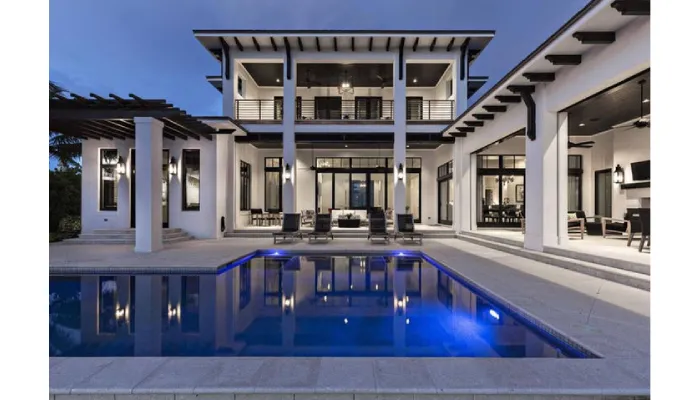When picking a Florida home design for comfort, it’s important to think about the hot, humid climate and frequent storms. Styles like Mediterranean or Mission offer stucco walls and red tile roofs that help keep homes cool. Elevated designs such as Tidewater homes protect against flooding while promoting airflow through many windows and covered porches. Inside, using tile flooring and quartz countertops helps with moisture resistance. Open floor plans with high ceilings improve ventilation, keeping the space feeling airy. Durable materials like fiber cement siding and impact-resistant windows make the home strong against weather challenges. Balancing these features ensures a comfortable living space suited to Florida’s environment.
Climate-Adaptive Architectural Styles for Florida Homes
Florida home designs humid climate and frequent storms have shaped home designs that focus on natural cooling, storm resistance, and flood protection. Mediterranean and Spanish-style homes are popular for their stucco or brick walls, low-pitched red terra-cotta tile roofs, and arched openings that promote airflow through open floor plans. Mission-style houses share many of these features but may include parapets or bell towers for added character. Tidewater or Low Country homes are raised on piers to avoid flood damage and often feature wide, covered porches that wrap around the house, maximizing shade and ventilation through numerous windows. The Old Florida “Cracker” cottages are simple, wooden, one-story homes elevated on rocks or bricks, designed to catch cooling breezes with their wide porches and many windows. Across these styles, shaded outdoor living spaces like porches and verandas play a critical role in reducing heat gain while blending indoor and outdoor areas. Open floor plans and strategically placed windows encourage cross ventilation, essential for cooling without heavy reliance on air conditioning. Roof designs tend to be low-sloped with heat-reflective and storm-resistant materials like metal or clay tiles. Using natural materials such as wood and stucco helps regulate humidity and indoor temperature, while architectural details address coastal challenges by incorporating flood protection, wind resistance, and moisture control. These design choices create homes that are comfortable, durable, and well-suited to Florida’s unique environment.
Design Features That Enhance Comfort in Florida Houses
Covered front and rear porches play a key role in keeping Florida homes comfortable by providing shade that reduces direct sunlight on walls and windows, which helps lower indoor temperatures. Low-slope roofs made from red tiles or metal not only deflect heat but also offer strong durability against hurricanes and heavy rains common in the region. Stucco exterior walls are popular because their thermal mass helps maintain cooler indoor temperatures and they resist moisture effectively. Strategic window placement captures prevailing ocean or natural breezes, improving natural ventilation and cooling throughout the home. Second-floor verandas extend living space outdoors while shading the lower levels from sun exposure, adding both comfort and usable space. Open floor plans with high ceilings encourage air circulation by allowing warm air to rise and cooler air to flow beneath, making interiors feel more spacious and less stifling. Screened-in pools and patios let homeowners enjoy the outdoors without worrying about insects, enhancing comfort during warm evenings. Wide eaves and roof overhangs shade windows and walls, cutting down on solar heat gain and protecting the home from harsh sun. Light-colored exterior finishes reflect sunlight, reducing heat absorption and keeping the home cooler. Cross ventilation is achieved by positioning windows and doors opposite each other, enabling steady airflow through living spaces and reducing reliance on air conditioning. These design features work together to create homes that respond well to Florida’s hot, humid climate while maximizing comfort both indoors and outdoors.
- Covered front and rear porches provide shade, reducing direct sunlight on walls and windows, which lowers indoor temperatures.
- Low-slope roofs made from red tiles or metal deflect heat and offer durability against hurricanes and heavy rains.
- Stucco exterior walls have thermal mass benefits and resist moisture, helping to maintain cooler indoor temperatures.
- Windows are placed strategically to capture prevailing ocean or natural breezes, improving natural ventilation.
- Second-floor verandas extend living space outdoors while shading lower levels from sun exposure.
- Open floor plans with high ceilings encourage air circulation, allowing warm air to rise and cooler air to flow beneath.
- Screened-in pools and patios allow outdoor enjoyment without exposure to insects, enhancing comfort.
- Wide eaves and roof overhangs shade windows and walls, cutting down on solar heat gain.
- Use of light-colored exterior finishes reflects sunlight, reducing heat absorption.
- Cross ventilation is achieved by positioning windows and doors opposite each other to enable airflow through living spaces.
Choosing Durable Exterior Materials for Florida Weather
Selecting exterior materials that stand up to Florida’s hot, humid climate and frequent storms is key for a comfortable, long-lasting home. Fiber cement siding is a smart choice because it resists moisture, pests, and fire while offering the look of wood or stucco with less upkeep. Stucco remains popular due to its durability and ability to handle humidity without deteriorating. Vinyl siding is another low-maintenance option, available in many colors and styles, and it holds up well against Florida’s intense sun and rain. For stronger protection, concrete block walls provide excellent resistance to hurricanes and moisture intrusion, making them a solid investment for safety and durability. Roofing materials also play a big role: metal roofing can endure strong winds and heavy rain and reflects solar heat to keep interiors cooler, while clay barrel tiles offer a classic look with good UV resistance, especially in coastal areas. Composite tiles combine weather and UV resistance with low heat absorption, adding to energy efficiency. Impact-resistant windows are crucial in Florida homes to protect against storms and reduce heat transfer, improving indoor comfort. Proper sealing and flashing around all exterior materials help prevent moisture penetration and mold growth, maintaining the home’s integrity. When choosing materials, it’s important to balance upfront costs with long-term durability and maintenance needs to ensure your Florida home stays comfortable and resilient over time.
Interior Materials and Finishes for Cool, Comfortable Living
When choosing interior materials for a Florida home, prioritizing surfaces that stay cool and resist moisture is key to comfort. Tile flooring is a top choice because it feels cool underfoot, stands up well to humidity, and is highly durable. Luxury vinyl plank flooring offers a great alternative with its wood-like appearance, water resistance, and easier upkeep compared to hardwood. While hardwood floors bring natural beauty, they require more care and can suffer damage in Florida’s humid climate if not properly maintained. For countertops, quartz is excellent since it is non-porous, low-maintenance, and available in many styles that suit humid environments. Granite resists heat and scratches but needs regular sealing to keep moisture at bay. Solid surface options like Corian provide seamless finishes that are easy to clean and repair, making them practical for busy kitchens and bathrooms. Cabinet choices also impact indoor comfort; solid wood cabinets such as maple, oak, or cherry offer classic warmth but must be protected from moisture and humidity to prevent warping or damage. Thermofoil cabinets, coated with vinyl, provide better water resistance and simplify cleaning, which is ideal in Florida’s moist conditions. Light-colored finishes throughout the interior can help reflect heat, keeping rooms feeling cooler and brighter. Ultimately, selecting materials that resist mold, mildew, and moisture damage supports long-lasting comfort and reduces maintenance challenges in Florida’s climate.
Energy Efficiency Tips for Florida Home Designs
To keep Florida homes comfortable and energy efficient, it’s important to design with the climate in mind. Position windows and openings to capture prevailing breezes, allowing natural ventilation and cooling without relying heavily on air conditioning. High ceilings paired with open floor plans help warm air rise and improve airflow throughout the space. Roof overhangs and covered porches are essential for shading walls and windows, which reduces the amount of heat entering the home. Choosing roofing materials that reflect solar radiation, such as metal or reflective tiles, can significantly lower indoor cooling needs. Installing energy-efficient, impact-resistant windows not only minimizes heat transfer but also adds protection during storms. Using insulation and house wraps made for humid climates helps control moisture and boosts HVAC system performance. Additionally, ceiling fans and ventilation systems that promote steady air movement can keep rooms comfortable while using less energy. Sealing gaps around doors and windows prevents hot, humid air from sneaking in, improving overall efficiency. Light-colored exterior paints and roofing materials reflect sunlight, reducing heat absorption and keeping indoor temperatures lower. Finally, integrating energy-efficient lighting and appliances reduces the home’s overall energy consumption, making it easier to maintain comfort without excessive utility costs.
Practical Factors When Selecting Florida Home Styles
When choosing a Florida home design, start by assessing your lifestyle needs, including how many bedrooms and bathrooms you require and whether you prefer more indoor or outdoor living space. Open floor plans are popular here because they offer flexibility, enhance comfort, and create a seamless flow between inside and outside areas, which suits Florida’s warm climate. Select durable, low-maintenance materials like fiber cement siding, stucco, or concrete block walls to withstand heat, humidity, and storms while keeping upkeep costs low. Balance the initial expense of these materials with the long-term savings from their durability. Collaborate with design-build professionals who understand Florida’s unique climate and building regulations; their expertise helps optimize your choices for both comfort and safety. Consider the home’s site carefully, taking into account flood risk and exposure to strong winds, which influence foundation design and overall resilience. Plan for practical storage and utility spaces that support hurricane preparedness and maintenance needs. Incorporate landscaping elements like trees and shrubs to provide natural shade and cooling, and add exterior shading devices such as awnings or pergolas to reduce heat inside the home. Finally, factor in neighborhood style guidelines and the potential resale value when selecting architectural styles and materials to ensure your home fits well within its context and remains a good investment.

Mary Burns is a dedicated writer focusing on health and fitness topics. With a passion for promoting wellness and vitality, Mary shares her knowledge and expertise through engaging and informative blog posts.




